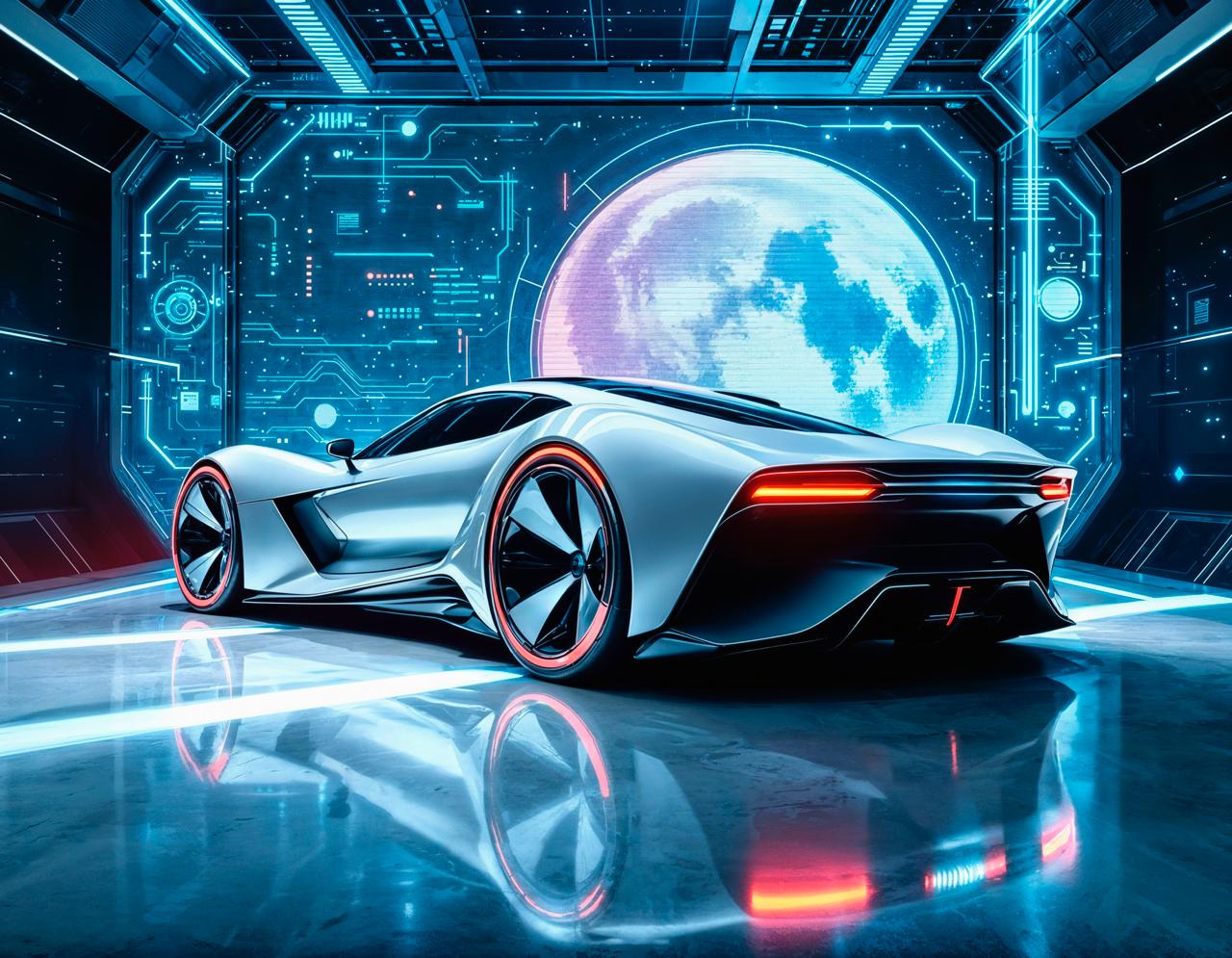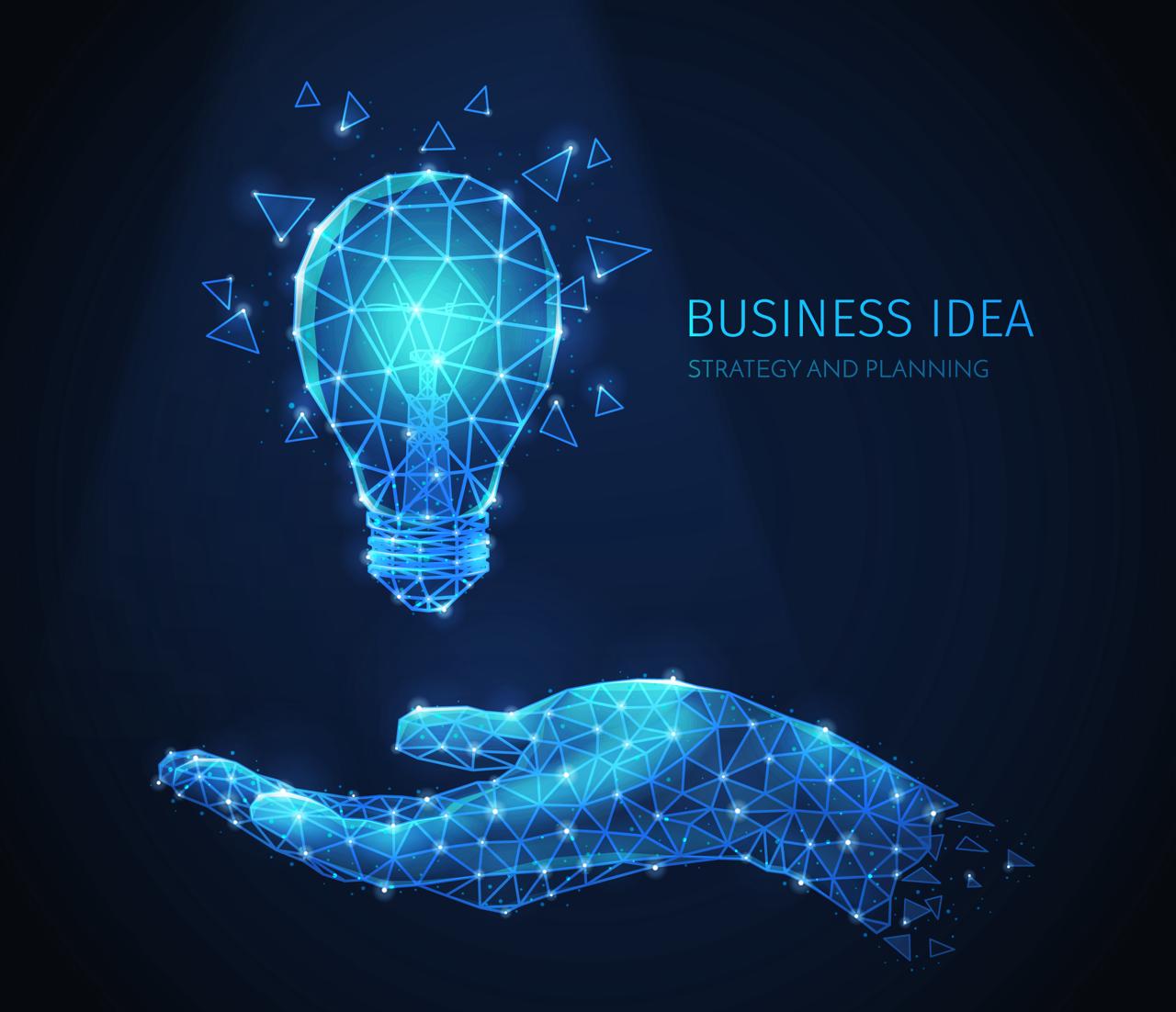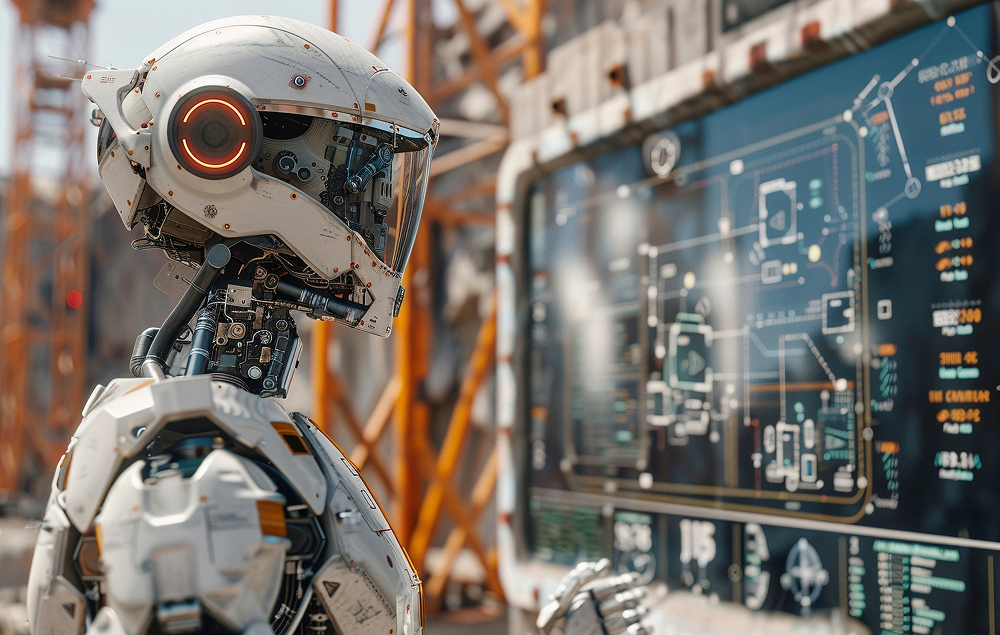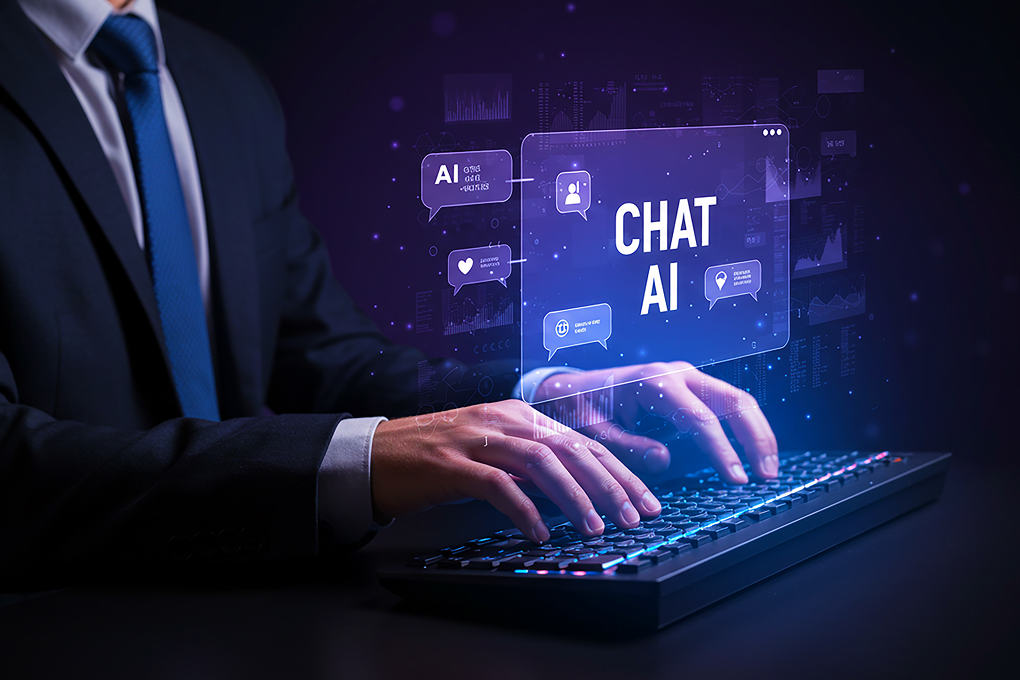Cars have changed a lot. Go look at any car factory now and it’s crazy how different things are. Robots do jobs that used to take twenty guys. Tesla’s cameras catch paint problems that people miss all the time. BMW’s machines tell them when they’re about to break so they don’t have to deal with emergency fixes that cost a ton.
Cars remember weird stuff now. Like where you get coffee or how hot you keep it in the morning. They’ve got more computer guts than old NASA rockets.
Mercedes made their paint robots smarter so they waste less paint. Ford uses cameras to keep workers from getting hurt. Car salesmen have programs that figure out what you want before you do. Companies not keeping up are getting killed by the ones that are.
AI Market Forecast in the Automotive Industry
AI in the automobile industry is poised for explosive growth, with forecasts suggesting that advanced driver-assistance systems (ADAS) and autonomous-driving (AD) technologies could generate $300 billion to $400 billion in revenues by 2035. These aren’t pie-in-the-sky numbers either. BMW dropped $7 billion on AI research last year. Tesla’s stock price reflects what Wall Street really thinks about AI-powered cars. The smart money is already moving.
Things are moving incredibly fast. Market size will nearly triple between 2025 and 2030. Lane-keeping assist and adaptive cruise control are just the beginning. Full automation is where the real money gets made. But it’s not just about self-driving cars. Ford’s AI factories already cut costs 15% while building better vehicles. Volkswagen prevents most equipment breakdowns before they happen using predictive systems. These aren’t future benefits – they’re happening right now.
The money keeps rolling in from everywhere now. Mercedes charges people monthly just to use fancy computer features that didn’t exist five years back. Warehouses order their own parts without anyone telling them to. Cars figure out how you like things and just do it. Investment guys are throwing money at anything with “AI” in the name. Old-school parts companies are buying up tech startups because they’re scared of getting left behind. Insurance companies have no clue how to price policies for cars that drive themselves.
What is the impact of AI on the automotive industry?
The car business got flipped on its head faster than anyone expected. Ten years ago, nobody would’ve believed what’s happening now. Factory floors used to be all human – now robots work right next to people and make calls that took old-timers decades to learn.
It started with assembly lines but spread like wildfire. Machines tell you they’re gonna break three weeks out. Toyota saves millions by fixing stuff before it actually breaks. Ford’s smart factories pump out cars 20% faster with way fewer screwups than when people did everything.
The cars themselves are where things get really crazy. Your car hits the brakes before your brain even knows there’s trouble. Lane-keeping nudges you back when you’re drifting off on long road trips.
Daily stuff got smarter too. Cars know you leave for work at 7:30 and fire up GPS without being asked. Air conditioning figures out what you like based on the weather and how you usually set it. Voice controls actually get what you’re saying instead of making you want to throw your phone out the window.
Electric cars squeeze every last mile out of their batteries through smart charging tricks. Factories waste way less metal and power because computers figured out better ways to do things.
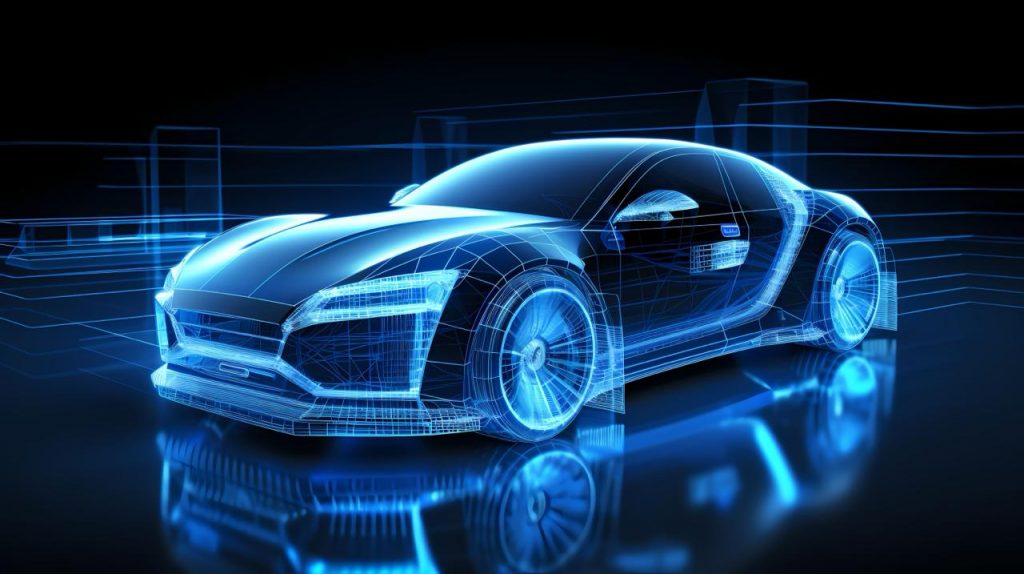
What are the advantages of artificial intelligence in the automotive sector?
Making Assembly Lines Less Brutal
Factory workers used to do the same arm motion 8,000 times a day until their shoulders were shot. Now robots handle that stuff while people do quality checks and make judgment calls. Ford’s plant in Kentucky pumped out twice as many cars last year and had 40% fewer people getting hurt on the job. The crazy part? AI catches screwups that people missed for years. When a paint sprayer went haywire at GM, the computer shut it down before 500 cars got ruined.
Design Gets Weird (In a Good Way)
Designers used to sketch for months, build clay models that cost a fortune, then pray everything worked. Now they dump rough ideas into a computer overnight and get back hundreds of wild variations by morning. Some look absolutely bonkers, but that’s the point.
Keeping Hackers Out of Your
Your car talks to the internet now, which is convenient until some kid in his basement decides to mess with your brakes from three states away. Now there’s AI watching every digital conversation your car has, and it’s basically a digital bouncer that kicks out anyone who doesn’t belong.
Fixing Trucks Before They Break
UPS used to guess when their trucks needed work. Change the oil every 5,000 miles, swap parts when they looked sketchy, hope nothing expensive exploded. Their AI watches engine shakes, how hot the transmission gets, how the brakes are wearing. It tells them three weeks before something’s about to fail. No more delivery trucks dying during Christmas rush.
Almost-But-Not-Quite Robot Drivers
Tesla owners can pretty much nap on the highway, but throw in some construction cones or a motorcycle weaving through traffic and suddenly you need human hands on the wheel. In Phoenix and San Francisco, Waymo actually runs taxis with no driver at all. Real people get rides in ghost cars. Works great on normal streets but gets confused when things get messy.
Saving Serious Cash
Ford cut $2.3 billion in waste last year just by having AI figure out better schedules and manage inventory smarter. That’s not “estimated savings” – that’s actual money that showed up in their bank account. A parts maker in Michigan dropped their power bill 15% by letting the computer decide when to run which machines.
Customer Service That Doesn’t Suck
Remember calling car dealerships? Transfer, hold, transfer, hold, then talk to someone who knew less about your car than you did. Now chatbots handle most of the simple stuff – book your oil change, explain what’s covered under warranty, figure out why your radio won’t connect to your phone. When you do get a human, they’re dealing with actual problems instead of “How do I pair my Bluetooth?”
Insurance That Actually Makes Sense
Car insurance used to be like throwing darts blindfolded. Two neighbors with identical cars might pay totally different rates because of their credit score or which side of the street they lived on. Now some companies track how you actually drive and give discounts to people who don’t drive like maniacs. When you do crash, AI looks at photos of the damage and cuts you a check before you finish talking to the claims guy.
No More Dealer Games
Buying a car used to be like poker where only the dealer knew what cards everyone had. They knew the real prices, the financing tricks, all the numbers you couldn’t get. AI tools flipped that table. Now you walk in knowing exactly what the car costs them, what financing should look like, what everyone else paid. Can’t pull the wool over anyone’s eyes anymore.
Moving Parts Without Chaos
Getting car parts from around the world to assembly lines is like juggling chainsaws. One late shipment in Thailand shuts down factories in three countries. AI watches every bolt and wire in real time. When a typhoon smashed a supplier in the Philippines, the system had already found backup sources and changed production plans before any human manager knew there was trouble.
Multiple Ways to See
Self-driving cars pack more sensors than a NASA probe because if one fails, people die. Lidar draws perfect 3D maps but rain screws it up. Radar works in storms but misses small stuff. Cameras catch details but go blind in the dark. AI mixes all that data together so when mud blocks one sensor, the others keep working.
Robot Cars Are Still Learning
Full self-driving is like that friend who’s always “almost ready” – close, but not quite there yet. Current systems crush highway driving and parking lots but get stumped by construction workers waving flags or kids chasing soccer balls. The cars keep getting smarter, just slower than the hype promised.
Teaching Computers to Actually See
Sounds easy until you realize how hard it is to tell a plastic bag from a small animal, or a shadow from a pothole, or real stop signs from graffiti. Early versions were embarrassing – one kept slamming the brakes for “STOP” spray-painted on walls, making cars randomly stop in the middle of cities. They’re way better now but still not perfect.
Safety Systems With Quirks
Modern cars prevent thousands of crashes daily even though they’re not flawless. Cruise control sometimes freaks out at overpasses. Lane-keeping fights you on curves. But insurance companies see way fewer accidents, so the math works out. Most people get used to the weirdness and appreciate not getting rear-ended.
Computers That Hit the Brakes
Emergency braking saves the most lives because it works when people space out, fall asleep, or are staring at their phones. Especially useful in parking lots where people bump into each other at low speeds. Some systems brake for flying napkins while missing actual dangers, but they prevent way more crashes than they cause.
Big Brother in the Driver’s Seat
Cameras watching you drive creep people out, but they catch microsleeps that cause highway crashes. They notice texting, eating breakfast, putting on makeup. Some can spot heart attacks and pull the car over safely. Privacy advocates have valid concerns, but it’s hard to argue with saving lives.
GPS That’s Almost Perfect
Google Maps changed everything with live traffic updates, though it’s not bulletproof. Sometimes it routes you through quiet neighborhoods to save two minutes, which annoys the locals. Rural areas get spotty data because fewer people use it there. Construction zones confuse it regularly. Still saves most people time and gas.
Talking to Your Car Like a Human
Voice controls finally work without making you sound like a robot. Early versions needed exact phrases and perfect pronunciation. Now you can say “I’m freezing” instead of memorizing the climate control commands. Still struggles with thick accents and crying kids in the back seat, but it’s light-years better than the old junk.
Cars That Know You Better Than Your Family
Modern cars remember that you like your seat warm, your music loud, and your coffee shop route. Music systems learn your taste and suggest new bands. Navigation remembers where you go and finds faster ways to get there. When it works right, it’s helpful. When it’s creepy, you turn it off.
Maintenance Based on Reality
Instead of changing oil every 3,000 miles like your dad did, AI considers how you actually drive. Highway miles are easier on brakes than city stop-and-go. Mountain driving beats up transmissions differently than flat commuting. Oil sensors check chemistry and give you real recommendations based on your car’s actual condition.
Making Every Drop Count
Shipping companies obsess over fuel costs because they add up fast. AI figures out everything from routes to engine settings. UPS famously avoids left turns to save gas – sounds silly but saves millions of gallons yearly. Regular drivers get apps that teach better driving habits to squeeze more miles from each tank.
Virtual Cars for Testing Ideas
Fleet managers can test maintenance schedules on computer models before trying them on real trucks. Want to see what happens if you change oil every 7,000 miles instead of 5,000? Run it virtually first. Test different parts suppliers, delay brake changes, try cheaper oil. Find out what breaks without actually breaking expensive trucks.
Juggling Multiple Power Sources
Hybrids and electric cars manage batteries, gas engines, brake energy recovery, sometimes solar panels – all at once. AI handles thousands of calculations per second, switching power sources while considering traffic, hills, weather, your driving history. You just press the gas pedal and it figures out the rest.
Making Electric Cars Less Stressful
Range anxiety is real even with better batteries. AI tackles this by optimizing charging speed, managing battery temperature, planning routes, controlling air conditioning usage. Smart charging waits for cheap electricity rates. Battery management prevents degradation while maximizing how far you can go.
Designs That Look Alien But Work Better
Generative design spits out shapes that look like they came from another planet but perform better than anything humans would design. Engineers tell the computer what they want and it explores thousands of possibilities. Results often look more like sea creatures than cars, but they slice through air better and protect passengers in crashes through totally unconventional forms.
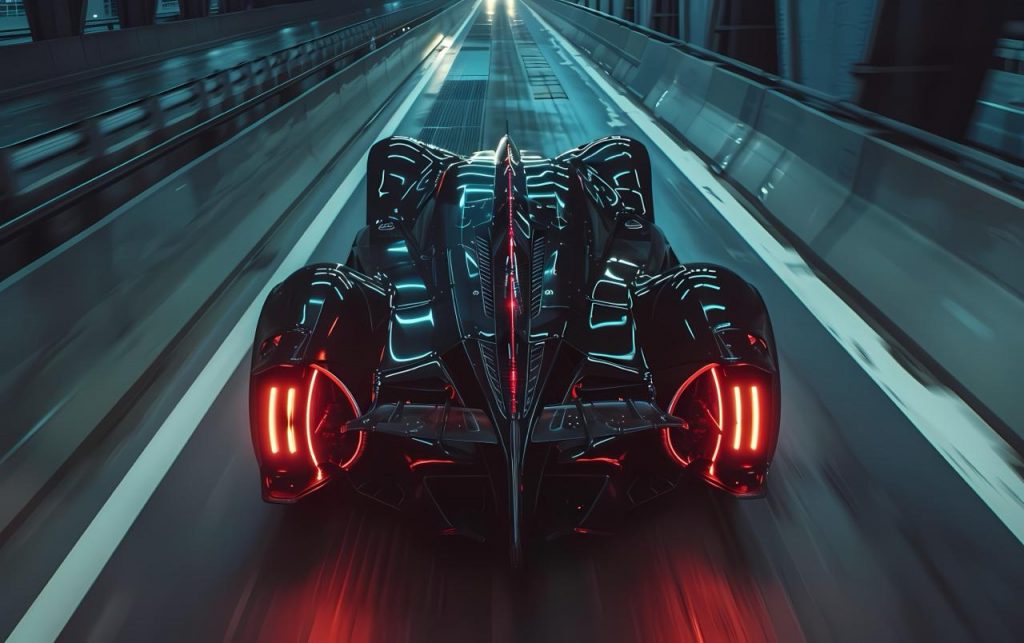
What are the use cases of AI in the automotive industry?
The car business has been turned upside down by AI applications that solve real problems. Walk through any modern auto plant or test drive a 2024 vehicle, and you’ll see dozens of examples.
Driver Assistance
Your car watches the road better than you do now. Cameras spot pedestrians stepping off curbs. Radar tracks vehicles in adjacent lanes. When you’re texting at a red light and traffic starts moving, the car notices before you do. Insurance companies track this religiously. Cars with full ADAS packages have 40% fewer claims. That translates to real premium discounts, not marketing gimmicks.
Speed Regulation
Speed cameras used to be the only enforcement. Now vehicles read traffic signs themselves and slow down automatically. European cars already come with mandatory speed limiters that prevent exceeding posted limits. Germany reports 15% fewer speed-related crashes where these systems are common. Fuel economy improves too since cars avoid pointless acceleration in school zones.
Route Guidance
Remember printing MapQuest directions before trips? Modern navigation processes 25 billion miles of driving data daily to predict traffic jams before they happen. Most people save 10-15 minutes on regular commutes through better routing. The algorithms get eerily accurate. Your phone knows about accidents before radio traffic reports mention them.
Marketing
Car dealers used to blast generic ads hoping something would stick. Now they target customers with surgical precision based on browsing history and demographic data. Look at truck websites for a week and F-150 ads will follow you everywhere online. Dealers report 3x higher conversion rates from targeted campaigns versus traditional advertising spray-and-pray methods.
Forecasting Analytics
Car companies used to guess how many vehicles to build and pray they got it right. Too many cars meant expensive inventory rotting on lots. Too few meant dealers yelling and customers walking away. Ford cut $800 million in storage costs by using computers that watch everything – job reports, weather, what people want in different states, even Twitter complaints – to know exactly how many cars to make.
Autonomous Vehicles
Self-driving still feels like science fiction, but the tech keeps improving. Tesla owners cruise highways with minimal intervention. Waymo runs actual robotaxis in Phoenix and San Francisco with paying customers. Construction zones still confuse most systems though. Aggressive human drivers create scenarios that weren’t in training data. Progress happens steadily, just slower than early hype suggested.
Driver Monitoring
Interior cameras watch for droopy eyelids and tilted heads that indicate fatigue. Some systems detect heart rate changes suggesting medical emergencies. Long-haul truckers benefit most, but regular commuters see safety improvements too. This prevents crashes caused by microsleep episodes – those brief moments when tired drivers nod off without realizing it.
AI in Manufacturing
Factory floors transformed completely over the past decade. Robots handle precision welding while humans focus on quality control and problem-solving. Computer vision spots paint defects that human inspectors missed for months. Toyota’s Georgetown plant doubled output with the same workforce. Quality metrics improved simultaneously as defect detection became more accurate.
Vehicle Design
Designers used to sketch hundreds of concepts by hand, then build expensive clay models. Now they feed requirements into computers that generate thousands of variations overnight. BMW discovered door handle shapes that looked weird but reduced wind resistance by 8%. Nobody would have tried those configurations manually.
Tire Design and Vehicle Aerodynamics
Tire development used to require years of real-world testing on different road surfaces. Michelin now simulates thousands of tread patterns digitally, cutting development time 60%. Aerodynamic testing happens the same way. Virtual wind tunnels replace expensive physical facilities while producing better results.
Aerodynamics
Computational fluid dynamics lets engineers test hundreds of body modifications rapidly. Subtle shape changes can improve fuel economy by 5-8% without affecting styling or safety. Race car teams pioneered these techniques. Now everyday sedans benefit from aerodynamic optimizations discovered through AI simulation.
Battery Chemistry Development
Electric vehicle batteries improve through AI-guided material science. Traditional development meant mixing chemicals, building test cells, waiting months for results. Tesla’s battery team explores thousands of material combinations digitally before building physical prototypes. Development cycles shortened from years to months.
Battery Management Systems (BMS)
Electric car batteries need constant babysitting to prevent overheating and extend lifespan. AI systems balance individual cells and adjust charging rates automatically. Proper management extends battery life 20-30% compared to simpler systems. That’s thousands in replacement cost savings for owners.
Supply Chain Management
Moving parts from thousands of suppliers to assembly plants requires incredible coordination. One delayed shipment shuts down production across multiple countries. When semiconductor shortages hit in 2021, companies with AI supply systems adapted faster. They identified alternative suppliers before human managers knew problems existed.
Vehicle Operation and Service
Cars now predict their own maintenance needs based on actual wear patterns, not arbitrary mileage intervals. Oil chemistry sensors know when changes are actually needed versus calendar schedules. UPS reports 30% fewer unexpected breakdowns through predictive maintenance. Fleet vehicles stay on the road instead of sitting in repair shops.
Personalized In-Car Experiences
Modern cars remember your preferences better than family members do. Seat positions, mirror angles, climate settings, radio presets – everything adjusts when you get in. Navigation learns your habits too. The system knows you stop for coffee Tuesday mornings and adjusts arrival estimates accordingly.
Enhanced Fleet Management
Companies managing hundreds of vehicles use AI for route optimization, driver coaching, and maintenance scheduling. Every trip gets analyzed for fuel efficiency and safety improvements. UPS credits AI fleet management with $400 million annual savings. Better routing cuts fuel costs. Predictive maintenance prevents expensive breakdowns.
Smart Cities and Vehicle-to-Vehicle/Vehicle-to-Infrastructure
Cars increasingly talk to traffic lights and each other. They share location data to prevent collisions and optimize signal timing for smoother traffic flow. Singapore reduced downtown congestion 25% through smart traffic management. Signals adjust based on real-time vehicle data rather than fixed schedules.
Adaptive Cruise Control
Highway driving became much more relaxing with AI-powered cruise control. The system maintains safe following distances automatically, speeding up and slowing down with traffic. Studies show 15% fewer highway accidents with adaptive systems versus traditional cruise control. Fuel efficiency improves through smoother speed management.
Automatic Lane Keeping and Lane Departure Warning
Lane departure accidents often cause serious injuries, especially on highways. AI monitors road markings and provides gentle steering corrections when cars drift unintentionally. Clear lane markings and good weather help these systems work best. Construction zones and faded paint still confuse most current versions.
Automatic Braking/Automatic Emergency Braking
Emergency braking hits the pedal faster than you can blink when trouble pops up out of nowhere. Government numbers show these systems stop over 50,000 crashes every year. They work best in parking lots and bumper-to-bumper traffic where people constantly bump into each other at slow speeds.
These applications keep expanding as technology improves and manufacturers find new ways to apply AI. The benefits are measurable enough that competitive pressure drives rapid adoption across the entire industry.
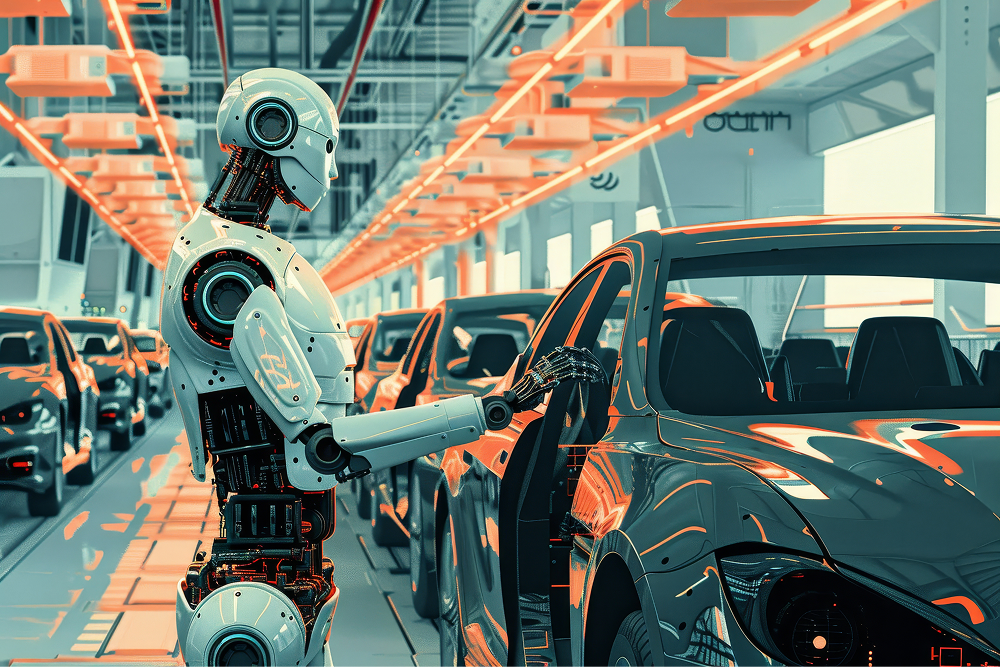
What are the Challenges of AI in the Automotive Industry?
The car industry’s AI push creates real headaches that nobody talks about much. Every cool new feature brings problems that engineers are still figuring out how to solve.
Lack of Control
Drivers hate feeling like passengers in their own cars. Your Tesla decides to slam on the brakes because it thinks an overpass is a stop sign. You’re fighting the steering wheel to avoid hitting a concrete barrier that the camera mistakes for a lane marker. This happens way more than companies admit. The fundamental problem? Computers don’t think like humans, especially when weird stuff happens that wasn’t in their training data. An experienced driver sees a construction worker waving cars around orange cones and knows what to do. The AI sees chaos.
Poor Data Quality
Teaching cars to drive means feeding them millions of road examples, but most come from boring highway miles in perfect weather because that’s cheap to collect. Crazy city intersections with jaywalkers and double-parked trucks? Not so much. Waymo mapped every pothole in Phoenix but their cars still can’t handle Boston’s messy streets. Plus people labeling road pictures make mistakes – one mislabeled stop sign teaches thousands of cars wrong.
Violation of Local Regulations
Laws move like molasses while tech moves at light speed. California lets companies test autonomous cars anywhere. Germany barely allows it at all. Who pays when an AI car crashes? Nobody knows because the laws don’t exist yet. Companies building global products face a nightmare – what’s legal in Texas might be banned in Tokyo. So they either stay local or build different versions for every country, which kills the economics.
Significant Limitations
AI chokes on situations that any teenager with a learner’s permit handles fine. Construction zones with workers directing traffic? Forget about it. Halloween kids in costumes? The car thinks they’re traffic cones. Heavy rain that covers lane markings? Game over. Even Waymo only operates in perfect conditions on mapped roads. Real driving involves drunk pedestrians, aggressive motorcyclists, and delivery trucks blocking bike lanes. Current AI isn’t ready for that chaos.
Community Acceptance
People don’t want robots driving their kids around. And it sounds smart. AAA says 71% of Americans are freaked out by self-driving cars. Every time a Tesla clips something, it’s all over the news. Many people who get a new BMW turn off every single driver assist thing the first day. They complain the car tries to “help” but it feels sketchy. Building trust takes forever, losing it happens in a heartbeat.
Transparency
AI systems are like teenagers – they make decisions but can’t explain why. Your car suddenly swerves left and you have no idea if it saved your life or almost killed you. Engineers can’t debug problems they can’t understand. When accidents happen, investigators need to know what the car was thinking. But the AI can’t tell them. It just points to billions of calculations that no human can interpret. Good luck explaining that to a jury.
Data Privacy
Your car knows more about you than your spouse does. Where you go, who you talk to, how fast your heart beats when you’re stressed. Modern vehicles are rolling surveillance systems. Most people have no clue how much data their cars collect. Companies sell this information to advertisers and insurance companies. Your “safe driver” discount might disappear if the car reports that you take corners too fast or brake too hard.
Ethical Guidelines
Who decides if your car should plow into one person to avoid hitting three others? Save your life or some kid crossing the street? People from different places see this stuff completely differently, but computers need simple yes-or-no answers. Car companies sure as hell don’t want to make that call and get sued. Politicians can barely figure out their iPhones. So some programmer decides who lives and dies, and nobody’s checking their work.
Testing and Regulation
How do you prove a self-driving car is safe? Computer simulations miss crucial details. Test tracks are too controlled. Public roads put innocent people at risk when things go wrong. Safety regulators understand crash tests and brake performance. They don’t understand neural networks and machine learning algorithms. So companies basically certify their own products and hope for the best.
Collaboration
Getting car AI right should be really simple. You just need to collaborate with car makers, tech companies, government types, and professors. But it’s often a problem. Companies tend to hide their crash data. Lawyers waste years arguing over who thought up lane-keeping first. Every country acts like whoever cracks self-driving cars first gets to rule the world. People keep dying in dumb accidents because nobody wants to help out the competition, even when it means saving lives.
The industry keeps pushing forward because the money is too big to ignore. But these problems won’t solve themselves quickly or easily.
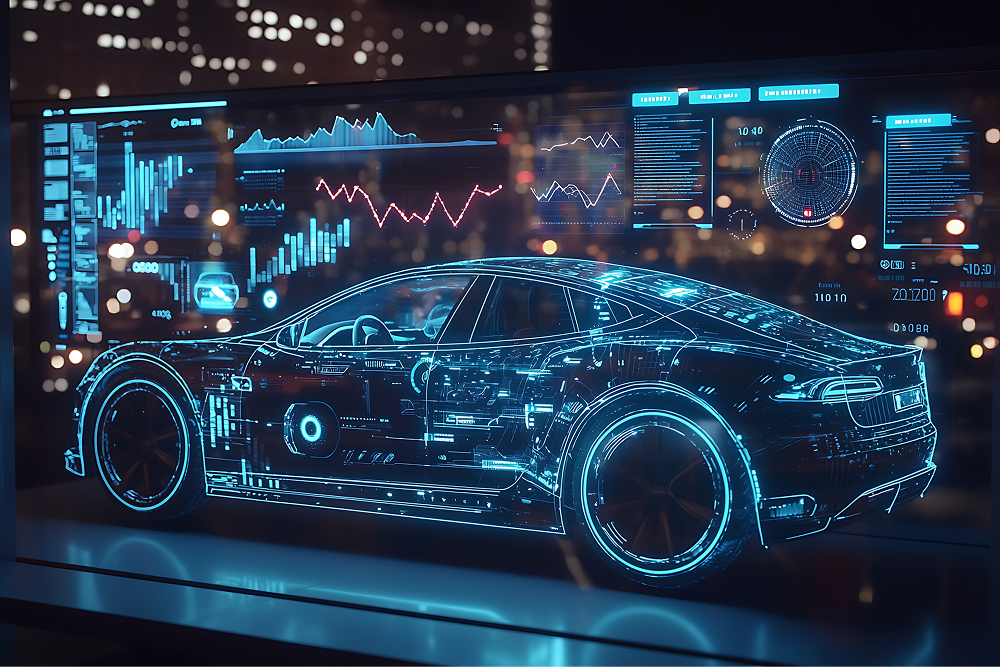
What is the Future of AI in the Automotive Industry?
Nobody really knows how automotive AI will play out. Driver assistance will get better, but it’s messier than anyone admits. Full self-driving keeps getting pushed back for obvious reasons. Predictive maintenance makes sense because fleet operators already save millions with it. Your car will definitely start telling you when parts need replacement based on actual wear instead of arbitrary mileage schedules. But older vehicles lack the necessary sensors, and most independent mechanics don’t know how to interpret AI diagnostics yet.
Cybersecurity will turn into a nightmare arms race. Cars connect to everything now, which gives hackers more ways to break in. Security researchers regularly demonstrate how to hijack vehicles remotely. AI security tools will help, but criminals use AI too. The more connected cars become, the more vulnerable they get.
Manufacturing will see steady AI improvements because the economics work. Generative design already helps engineers explore thousands of possibilities quickly. But custom-built vehicles for every customer? That’s a marketing fantasy. Mass production still costs way less than personalization, regardless of what AI can design.
Privacy concerns will persist because companies prioritize profit over protection. Most people trade personal data for convenience without thinking about consequences. Until consumers actually demand better privacy or governments force changes, manufacturers will keep collecting everything they can.
The real constraint isn’t technology – it’s money. AI development requires massive investment that only giant companies can afford. This concentrates power among Google, Tesla, and major automakers while squeezing out smaller innovators. We’ll probably end up with fewer players controlling automotive AI instead of the diverse ecosystem that drives rapid progress.
Progress will happen through boring incremental improvements, not revolutionary breakthroughs. Laboratory demonstrations always look more impressive than real-world implementation proves to be.
Conclusion
AI is changing the car business, but not in the dramatic ways tech companies promise. Safety features work better, factories run smoother, and cars learn your preferences. The problems are just as real though – nobody trusts their car with their personal data, and self-driving still can’t handle basic city driving. The hype doesn’t match reality. Full autonomy keeps getting pushed back because current systems fail at things any human driver handles easily. Real progress happens slowly through boring improvements. Lane-keeping gets a bit better. Predictive maintenance actually saves money so it spreads quickly. Companies face an impossible balance. Rush AI features to market and people get hurt, destroying trust that takes decades to rebuild. Move too cautiously and competitors grab market share. Tesla learned this the hard way with several high-profile Autopilot crashes. Trust matters more than technology. One major hack exposing millions of drivers’ personal data could kill public acceptance overnight. People need to believe these systems actually work before they’ll use them. Looking to implement automotive AI without the headaches? We help companies navigate this tricky landscape safely. Our team knows where the real opportunities are versus the marketing nonsense. The winners will solve actual human problems instead of chasing flashy demos that look good in presentations but fail on real roads.
